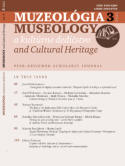Spatial Distribution Model for Targeting the Support for Cultural Institutions’ Development: A Case Study of Slovakia
Spatial Distribution Model for Targeting the Support for Cultural Institutions’ Development: A Case Study of Slovakia
Author(s): Kristina Baculakova, Martin GressSubject(s): Politics, Museology & Heritage Studies, Business Economy / Management, Cultural Anthropology / Ethnology, History of Education, Rural and urban sociology, Economic development, Marketing / Advertising
Published by: Univerzita Komenského v Bratislave, Filozofická fakulta
Keywords: spatial differentiation; cultural institutions; cluster analysis; regional development; Slovakia;
Summary/Abstract: Culture is one of the main tools for developing regions and reducing regional disparities. It is a significant job creator; it participates in social cohesion representing a catalyst for economic growth. In practice, when boosting the potential of cultural and creative industries, we encounter an insufficiently developed approach to evaluating the initial conditions for the allocation of financial resources for its development. This paper’s objective is to identify, map, and analyse spatial concentration of cultural institutions in Slovakia. The intention of the analysis was the identification of regions and districts with the potential for full use of cultural capital as a tool for sustainable regional development as well as the setting of cultural policy. The cluster analysis pointed out significant differences in the representation of cultural institutions in individual regions and districts of Slovakia. The regions with the most desirable results (e.g., Bratislava, Trnava, or Nitra) have some common characteristics linked to the local context, such as historical development, good infrastructure, concentration of educational institutions. The results also confirmed the assumption that within the regions, cultural institutions will be concentrated in larger district cities, specifically in the case of Bratislava even inside the city. From the cluster analysis it is possible to observe a “belt of districts” of Southern, Central, and Eastern Slovakia, which do not have sufficient cultural infrastructure. Since the process of shaping the supportive policy for cultural industries is now ongoing in Slovakia, we consider mapping the situation as one of the key elements in the policy-making process.
Journal: Muzeológia a kultúrne dedičstvo
- Issue Year: 9/2021
- Issue No: 3
- Page Range: 93-112
- Page Count: 20
- Language: English

